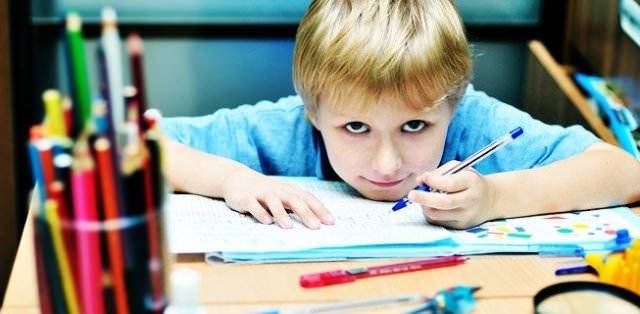How to identify left-handed, right-handed and ambidextrous children using tests?
You can determine whether a child is right-handed, left-handed or ambidextrous using special tests. Usually, dominance of one hand is established after 4 years of age. Testing is recommended at this age. To ensure reliable results, all test tasks must be completed quickly and without preparation. The child should not even guess about the true purpose of the event.
Tests to determine left-handedness and right-handedness
Test M. Ozyas
Ask your child to do the following:
- Screw the cap onto the bottle.
- Use scissors to cut the paper.
- Thread the thread through the beads.
- Clean shoes with a brush.
- Wind the thread onto the spool.
- Erase the drawn details with an eraser.
- Pour water from glass to glass.
- Lay out the pictures (cards).
- Make holes with a hole punch.
- Thread the needle.
- Unscrew the nut by hand and using a wrench.
- Clean things from dust.
- Use a pipette to drop into the neck of the bottle.
- Use a spoon to remove the bead from the glass.
- Zip and unzip.
- Take a few sips from the glass.
- Take a bell in your hand and ring it.
F. Kretschmer test
When passing F. Kretschmer's test to determine the leading hand, children are asked to perform the following actions:
- brush your teeth;
- To water flowers;
- push the ball with a stick;
- mix the sand with a spatula;
- put small toys in a box;
- remove the plug from the bathroom;
- take books from the shelf.
Which hand the child uses more when performing the above test tasks, that hand is the dominant hand in the baby. It is advisable that the child perform all actions without preparation or explanation of the essence of this test; this is the only way to obtain the most accurate data.
Other tests:
- Drawing . The essence of the method is for the child to draw what he wants. After the work is done, you need to invite the child to draw the same thing only with the other hand and then evaluate the result. A drawing made with your dominant hand will be clearer and more accurate. Also pay attention to the tension in your hands while drawing. The leading hand will be relaxed, and its movements will be clear and coordinated.
- Matchbox test . Prepare several boxes. One of them should contain a match with a broken end. The child needs to open the boxes in order to find a match. The main hand is the one with which the baby will push and push the moving part of the box.
- Test with sticks. The child needs to build a house out of sticks. The hand that performs the most active actions is the dominant one.
- Ball . Invite your child to throw you a small ball (for example, a tennis ball) with each hand, toss it and catch it. This task will be easier for the child to complete with his dominant hand.
- Cutting with scissors . The child needs to cut out a picture, for example, from a magazine. See which hand makes the most movements. Perhaps the baby will hold the scissors in his right hand, but they will be motionless, and the picture in his left hand will move. Therefore, the baby is left-handed.
- Laying out cards . Invite your child to lay out cards (for example, lotto). The child will lay out with the dominant hand.
There are a lot of tests to determine the dominant hand in children. By checking them, you can determine whether your child is right-handed or left-handed. It is worth keeping in mind that if there are left-handers in the family, then the likelihood that the child will be left-handed increases significantly. If a child cannot identify his dominant hand, then most likely he is ambidextrous, that is, fluent in both hands.
How to determine ambidexterity: test for children
There is a special test that allows you to determine whether a child is ambidextrous. It consists of asking the child to write the same text with both hands at the same time. A right- or left-handed person writing with both hands at the same time will write legibly with the dominant hand, and the second hand will simply draw a wavy line. But if the child is ambidextrous, then when performing this text, he will almost immediately, or at most after a few minutes of training, get two identical texts written by different hands. Moreover, these texts can be written in one direction or in different directions.
Features of teaching left-handed children
How to teach left-handed children
Currently, due to major changes in the field of education, much attention is paid to the development of individuality and the education of a full-fledged personality.
All innovations and psychological and pedagogical approaches strive to introduce into their programs conditions in which all students and pupils would be equally comfortable. The problem of a child’s adaptation in life always worries parents. And any deviation from generally accepted norms, even not necessarily pathological, causes them concern. Sometimes adults strive at all costs to adjust the child to general standards, for his own convenience. Very often, parents want to retrain their left-handed children, believing that this is wrong. But is this really so? The relevance of this study is due to the large number of issues related to this problem and the very small degree of its development. Society has an ambiguous attitude towards left-handedness; some consider it a serious disadvantage, while others consider it a manifestation of genius. There are legends about the fantastic abilities and even genius of left-handed people. But these are just legends. Upon careful analysis, information about left-handedness as a pathology turns out to be equally unproven. Society has an ambiguous attitude towards left-handedness; some consider it a serious disadvantage, while others consider it a manifestation of genius. The existence of such extreme points of view indicates that this phenomenon has been poorly studied. Most of humanity is right-handed. There are much fewer left-handers, according to researchers from different countries, from 5 to 30%. It is noted that there are people who are strongly left-handed or strongly right-handed, that is, those who are most active with one or the other hand, and there are ambidexters - people who are equally good at using both limbs. The number of left-handers decreases noticeably as people get older, but this does not mean that left-handedness disappears on its own. It’s just that the social environment forces them to relearn, sometimes with great difficulty. There are two definitions: “left-handedness” and “left-handedness.” According to the famous Russian neuropsychologist, professor at Moscow State University of Psychology and Education A. V. Semenovich, left-handedness is a preference and active use of the left hand, i.e. an external manifestation of the fact that for some reason the right hemisphere of the brain has taken (temporarily or permanently) the main, leading role in ensuring voluntary movements. Left-handedness can also be a temporary symptom. This may be due to a delay in the formation of interhemispheric interactions in the baby, and as the functional potential of the left hemisphere increases, a “transformation” of a left-handed person into a right-handed person may occur. But this does not always happen. As for the concept of “left-handedness,” according to A. V. Semenovich, this is a manifestation of a stable, unchanging psychophysiological characteristic, a specific type of functional organization of the nervous system (primarily the brain) of a person, which has fundamental differences from that of right-handers, if this left-handedness is genetic . In other words, left-handedness is not just a preference for the left hand, but also a completely different distribution of functions between the hemispheres of the brain. Left-handedness can also be associated with dominance of the left eye, left ear, or left leg. The lack of knowledge of this problem is largely due to the fact that domestic teachers and parents have been actively and for a long time retraining left-handers, although in many countries of the world in which left-handed children are not only not retrained, but also create conditions for a normal existence, training, and obtaining a profession, this is not any "negative feature". In such countries there are special stores for left-handed people, where you can buy knives and scissors, various tools, sports equipment, sewing machines and even computers with keyboards adapted for left-handed people. Unfortunately, we don’t have this; perhaps the limitation in the choice of certain professions is what pushes parents to retrain. The characteristics of left-handed children lead to a special subject-development environment, special, specialized programs, recommendations for parents and teachers on the training and education of left-handed children. But, unfortunately, in domestic pedagogy and psychology there are no full-fledged such programs, there are only individual recommendations, elements of programs and individual advice, which are very little tested and too scattered, which greatly complicates training and education for both teachers and parents, and of course and directly to the children themselves. And while there are no such conditions in our country, left-handed children face a lot of difficulties when entering an educational institution. According to research by M.M. Bezrukikh, adaptation reactions of left-handed students are difficult, which often leads to the risk of school maladaptation, school stress, and the risk of difficulties in the learning process. The most acute problem is the problem of left-handedness, which in terms of the functional organization of the brain is not always simply the opposite of right-handedness; rather, a different nature of the functioning of the brain can be noted. In this regard, a child’s psychological problems can begin not only upon entering school, but also with an incorrect and oppressive approach from teachers and parents, they can also manifest themselves in a preschool institution. The most common negative consequence is asthenic neurosis, in which there is increased fatigue, rapid exhaustion of the nervous system, and a sharp decrease in performance. Headaches, restless sleep, irritability, incontinence appear, and appetite decreases. Affective reactions are noted: violent outbursts of discontent, refusal to work. Neurosis can manifest itself differently in boys and girls. Boys are characterized by disinhibition, restlessness, and motor restlessness. And for girls, low mood, lethargy, and tearfulness are more typical. Quite often, left-handed children are worried about fears of failure and reproach from teachers and parents. For some children, fears are short-lived, and if there are no new stresses, they may disappear. And in order to avoid the above problems, it is necessary to study the problem of functional asymmetry of the brain and left-handedness as actively and globally as possible and to convey the research results to employees of educational institutions and parents. At the present stage, there are some authors who have contributed to the development of this topic. For example, Bezrukikh M.M. There are works with recommendations for parents on the upbringing and methods of adaptation of left-handed children, publications characterizing left-handed children, their characteristics and individuality, which describe the difficulties and problems of such children with possible solutions, and there are also methodological developments in the form of notebooks for classes with left-handed children . Also, such authors as Chuprikov A.S., Dobrokhotova T.A., Arakelov G.G. also have publications on this topic. But to achieve significant success in development and education, as well as to create full-fledged and high-quality programs that could be implemented in general education preschool and school institutions and successfully bring into life such a group of people as “left-handers,” there are very few of them. And accordingly, there is a very high probability that children will still continue to experience difficulties and discomfort when adapting and functioning in kindergartens, schools and in later life. Our study was conducted on the basis of MADOU No. 48 and consisted of selecting left-handed children by testing according to the methods proposed by M.M. Bezrukikh. (“interlocking of fingers”, “Napoleon’s pose”, “simultaneous actions of both hands”, “speed of movements”), as well as using the methods of F. Kretschmer (watering flowers, pouring sand with a spatula, brushing teeth, pushing a ball with a stick, getting books from the shelf, open the zipper). Based on the results of the ascertaining experiments, 10 children aged from 3.5 years to 6.5 years with different functional asymmetries of the brain were identified. Studying their adaptation cards, medical records, identifying characteristics by interviewing parents and educators. The formative experiment consisted of developing the main directions of psychological and pedagogical support for children with different functional asymmetries of the brain in a preschool institution, the goal of which was to implement a person-oriented approach to children, taking into account their characteristics; and, directly, the implementation of the developed support system. Based on the results of our research, a list of recommendations was identified for working with left-handed children. Some of them: - most importantly: do not show your negative attitude towards the child’s left-handedness!
— during classes, it is recommended that left-handed children be seated on the left at the table so that the child does not interfere with the neighbor, thereby not feeling insecure and uncomfortable; — when learning material, left-handers cannot repeat it automatically to themselves; it is necessary to use special techniques, the associative method is especially effective; — during productive work, it is advisable to use special products for left-handed people (for example, scissors, pens); - organize a rational daily routine for the child, without overload, since left-handed children, as a rule, are excitable and get tired quickly; — perform special exercises and games that develop visual perception and hand-eye coordination; - classes should begin and end with tasks that children can easily cope with; - actively use games and exercises aimed at interaction between the hemispheres. In conclusion, I would like to note that many parents are interested in whether left-handers have any differences from right-handers and which of them adapts better to the school environment and gets higher grades. Left-handed children will learn much better than their right-handed peers if, before the start of classes, in the preparatory period, that is, in kindergarten, certain educational work is carried out with them, otherwise they will lag behind right-handers. This is due to the specificity of left-handed people’s processing of information. and first of all, I would like to note that it is important to develop personality and individuality, to form high moral and ethical qualities, regardless of which side of the hemisphere dominates, and what is also very important: the forced retraining of left-handed children, and thereby the forced change of the existing system brain function leads to undesirable consequences. And in order for a left-handed child to be as comfortable as possible in the right-handed world around him and to protect him from unnecessary difficulties, it is necessary to identify and understand his characteristics. This is why it is necessary to work through and study this problem as actively as possible, so that raising and educating left-handed children will not pose any problems in the future. Moreover, according to some studies, the percentage of left-handed children increases significantly every year. Bibliography:
1. Bezrukikh M. M. “Left-handed child” - M., 2001 2. Bezrukikh M. M., Efimova S. P. “Why is it difficult to study.” 3. Bezrukikh M. M. Left-handed child: Notebook for activities with children. Methodological recommendations. M.: Ventana-Graf, 2001 (Getting ready for school). 4. Bezrukikh M. Left-handed child at school and at home. - Yekaterinburg, 1998. 5. Copybooks of Bezrukikh M. M. “Left-handed child” (series “Getting ready for school”). - M., 2004. pp. 18-48.
We recommend watching:
Consultation for parents “Using self-massage to improve the health of the child’s body” Parental competence
How to organize a walk with your child in winter Consultation for parents. A child's heart is a sacred place
Similar articles:
How to prepare a child's hand for writing
Consultation for parents “Construction from building materials”
Advice for parents: Don’t make an idol out of your child
Consultation for parents. Preparing a child for kindergarten
Adaptation of young children to kindergarten
Why is a child born right-handed, left-handed or ambidextrous?
Difference between left-handers, right-handers and ambidextrous people:
- Right-handed . Most people are right-handed. Their left hemisphere of the brain is most developed. It is responsible for logical and abstract thinking, as well as speech.
- Lefties . In such people, the right hemisphere dominates. Left-handers are distinguished by unique creative abilities and have well-developed imaginative thinking.
- Ambidextrous . If a child is ambidextrous, both hemispheres process information simultaneously and at the same speed.
Most often, the ability to own one or another hand is formed during prenatal development. Both hormonal levels and heredity play a big role here. It is believed that boys are most often born left-handed, and in girls, left-handedness manifests itself if the mother’s testosterone (male hormone) level was increased during pregnancy.
There is also an opinion that the dominant development of the right hemisphere is influenced by rapid childbirth, since in this case mild brain injury is possible. The reasons for ambidextrous people are unknown. But there is an assumption that this is a new round of evolution in the development of mankind. Recently, the number of people who are fluent in both hands has been growing.
Why is the child left-handed?
Why is the child left-handed? We all know that the hemispheres of the human brain perform different tasks. So, for example, the right controls the left hand and eye, is responsible for imaginative thinking, a sense of rhythm, perception of intonation and music, orientation in space, feelings. The left is subject, respectively, to the right hand and eye, speech skills, reading, writing, mathematical calculations, analytical abilities, movements. One of the hemispheres is dominant. For right-handers - left. The left-handed hemispheres “agreed” with each other differently, and the right one became the main one. However, in words it’s all so simple. In fact, it may be that the child’s left hand is dominant, but the right eye is the main one. There is also such a term as hidden left-handedness. This means that a person usually uses his right hand, but prefers to do some things with his left. Or he can use both hands equally deftly.
The reasons for a child’s “left-handedness” can be different, for example:
- birth injury resulting in damage to the right hemisphere
- heredity (if there were left-handed people in your family, then it is likely that your baby is like that too)
- intrauterine effects of testosterone on the cerebral hemispheres
- imitation of left-handed relatives
- childhood injury to the right hand and inability to use it for some time
Features of the development of left-handed children

Such children, as a rule, have excellent musical and/or artistic abilities, have excellent hearing, are emotional, love and can imagine, and often achieve great success in sports. Such a child thinks about mathematical calculations in a completely different way than right-handers, but often comes to the right result in this unexpected way. And in general, about a fifth of all known talents are left-handed. Therefore, parents should definitely think about having their child join one or another club or section, depending on what type of art or sport he is drawn to and what abilities he shows. But at the same time, left-handers often have disturbances in the development of oral and written speech, and problems with motor activity. Therefore, you will need to work with them a lot in order to eliminate certain shortcomings (for example, talk more often) or even take them to a specialist. Also, such children are often stubborn, capricious, restless and sensitive, so you will have to vigilantly monitor the microclimate within the family. Is it necessary to retrain a child to be left-handed? In no case! Firstly, this way you can instill complexes in him. On the contrary, it should be explained that such a feature does not make him worse than others, and that using his left hand is not a deviation from the norm. Secondly, it is a huge stress for the child. And thirdly, since we are talking not just about the leading positions of one or another hand, but about brain activity, retraining can cause various failures and unpleasant consequences.
Try to start teaching your child as late as possible what he may initially fail at (for example, it is better to start learning reading, writing or foreign languages directly at school age) and, on the contrary, engage with him in what he succeeds in (drawing , singing, etc.). And don’t forget to encourage his every achievement! Remember, this baby is especially sensitive, so you need to be especially careful when communicating with him. And if you see that a child is very worried about his characteristics, and you are unable to cope with this, be sure to show him to a child psychologist.
Psychological characteristics of left-handed, right-handed children and ambidextrous children
Different hemispheres of the brain perceive information differently, which explains some of the features and differences in the behavior of right-handed and left-handed people, as well as ambidextrous people.
Psychological portrait of left-handers, right-handers, ambidextrous people
- handers are conservative, principled, consistent, predictable. They are distinguished by emotionally stable behavior, have analytical, abstract thinking, almost never argue or quarrel, and are characterized by precision and accuracy.
- Lefties are impulsive, emotional, stubborn and withdrawn, strive for change, progress, have poor spatial orientation, and have a creative nature.
- Ambidexterity is universal, intellectually developed, with good intuition, has high creative potential, analytical thinking with a penchant for genius, achieves high results in everything.
Ambidextrous and left-handed children often have learning difficulties and therefore require special attention. It is necessary to raise any child taking into account his characteristics. However, if you have difficulties raising left-handed or ambidextrous children, then you need to contact a psychologist who will help you unlock your child’s potential.
Is it worth retraining lefties?
Previously, using the left hand was considered a pathology, a deviation from the norm, so children were retrained to be right-handed. This was accompanied by psychological trauma for little left-handers, and the methods used for retraining could not always be called humane. Now psychologists and teachers do not recommend retraining left-handed people to become right-handed, as this can cause anxiety, fears, neuroses and protests in the child. Interference with the natural distribution of functions between the hemispheres contributes to the development of isolation in the child, awkwardness in movements and low self-esteem.
Advice from an expert
Educational and clinical psychologist, psychoanalyst psychologist Lyudmila Vladimirovna Altyeva (St. Petersburg) gives the following advice to parents of left-handers, right-handers, and ambidextrous people:
Parents can notice that a child prefers to use one hand or another at a very early stage. Thus, the baby will more often manipulate an object with his dominant hand (suck a fist, grab a toy, bottle, etc.). By 1.5 - 2 years, this trend becomes more permanent. For example, a child takes a spoon only with his right or left hand. It is at this time that parents/caregivers make an attempt to teach the child to use the “correct” hand. However, the main help for the baby will be to invite him to decide on this issue himself - not to put the object in the handle, but to put it so that he can take it with both hands. In kindergarten/school, teachers can and should be warned that the child prefers to use his left hand. Now teachers treat such children with understanding. And, perhaps, the most important thing. Having read about the psychological portrait of right-handers, left-handers and ambidextrous people, you need to smile, take note and come to the conclusion that intuition, creativity and the ability to build relationships are not only a physiological given, but also something that can and should be actively developed in a child.
Physiology of left-handed children
Left-handedness is the predominance of the functions of the left hand, associated with the characteristics of the brain. Determining the dominant hand in preschool age is difficult, since brain structures are formed unevenly. The right hemisphere matures by age 5. It is responsible for imaginative thinking and controls the left side of the body.
Before school age, the dominant hemisphere may change several times
In turn, the left hemisphere matures later - by 8-12 years. It is responsible for speech and the ability to think logically. The corpus callosum (plexus of nerve cells) takes even longer to form and is responsible for the correct interaction of the hemispheres. There are children in whom both hemispheres are equally developed, but this phenomenon has not yet been studied enough.
If you diagnose a group of children at 3 years old and repeat it 6-7 years later, in the first case there will be much more left-handed people among them. This means that it is too early for parents of a 2-5 year old child to draw conclusions that their child is left-handed, even if he actively uses his left hand. The right hemisphere of the brain wins much more often and most people are right-handed. That is why the modern world is organized for their convenience.








